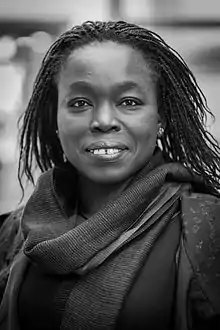سيريريون
السيريريون (بالإنجليزية: The Serer people) هم مجموعة عرقية دينية توجد في غرب أفريقيا.[4][5] يُعدون ثالث أكبر مجموعة عرقية في السنغال، ويشكلون ما نسبته 15 ٪ من السكان السنغاليين.[6] ويتواجدون أيضًا في شمال غامبيا وجنوب موريتانيا.[7]
 _by_Erling_Mandelmann.jpg.webp) |
| فاتو ديوم |
| مجموع السكان |
|---|
| أكثر من 1.8 مليون[1] |
| المناطق مع الدلالات الإحصائية |
|
| اللغات |
|
Serer proper، Cangin languages، لغة ولوفية |
| الديانات |
|
Majority إسلام،[2] Christianity[3] and ديانة سيريرية (a ƭat Roog) |
| المجموعات الإثنية المرتبطة |
نشأ السيريريون في وادي نهر السنغال على حدود السنغال وموريتانيا، وانتقلوا جنوبًا في القرنين الحادي عشر والثاني عشر، ثم مرة أخرى في القرنين الخامس عشر والسادس عشر عندما غُزِيَت قُراهم وتعرضوا لضغوط دينية.[8][9][10] لقد كان لديهم ثقافة حضرية مستقرة ومعروفين بخبرتهم في الزراعة ورعي [الإنجليزية] الماشية الموسمي.[9][11]
مراجع
- Agence Nationale de Statistique et de la Démographie. Estimated figures for 2007 in Senegal alone
- http://books.google.co.za/books?id=MdaAdBC-_S4C&lpg=PP9&ots=dN8QkJvmbQ&dq=The+Peoples+of+Africa:+An+Ethnohistorical+Dictionary&pg=PA516&redir_esc=y#v=onepage&q=The%20Peoples%20of%20Africa:%20An%20Ethnohistorical%20Dictionary&f=false The Peoples of Africa: An Ethnohistorical Dictionary نسخة محفوظة 2014-12-02 على موقع واي باك مشين.
- http://books.google.com/books?id=waW03E44v3AC&lpg=PA44&vq=serer&pg=PA44&redir_esc=y#v=onepage&q=serer&f=false The Gambia and Senegal نسخة محفوظة 2014-06-27 على موقع واي باك مشين.
- "Charisma and Ethnicity in Political Context: A Case Study in the Establishment of a Senegalese Religious Clientele", Leonardo A. Villalón, Journal of the International African Institute, Vol. 63, No. 1 (1993), p. 95, مطبعة جامعة كامبريدج on behalf of the International African Institute نسخة محفوظة 5 يونيو 2019 على موقع واي باك مشين.
- Villalón, Leonardo A., Islamic Society and State Power in Senegal: Disciples and Citizens in Fatick, p. 62, مطبعة جامعة كامبريدج (2006), (ردمك 9780521032322)
- Senegal, CIA Factsheet نسخة محفوظة 2021-02-04 على موقع واي باك مشين.
- Ethnologue.com نسخة محفوظة 2012-10-04 على موقع واي باك مشين.
- Galvan, Dennis Charles, The State Must Be Our Master of Fire: How Peasants Craft Culturally Sustainable Development in Senegal Berkeley, University of California Press, 2004 p. 51
- Elizabeth Berg; Ruth Wan; Ruth Lau (2009). Senegal. Marshall Cavendish. صفحة 63. ISBN 978-0-7614-4481-7. مؤرشف من الأصل في 3 مارس 2021. الوسيط
|CitationClass=تم تجاهله (مساعدة) - Leonardo A. Villalón (2006). Islamic Society and State Power in Senegal: Disciples and Citizens in Fatick. Cambridge University Press. صفحات 54–55. ISBN 978-0-521-03232-2. مؤرشف من الأصل في 03 مارس 2021. الوسيط
|CitationClass=تم تجاهله (مساعدة), Quote: "Serer oral tradition recounts the group's origins in the Senegal River valley, where it was part of, or closely related to, the same group as the ancestors of today's تكرور." - Natural Resources Research, يونسكو, Natural resources research, Volume 16, Unesco (1979), p. 265
- بوابة علم الإنسان
- بوابة غامبيا
- بوابة موريتانيا
- بوابة السنغال
- بوابة الأديان
